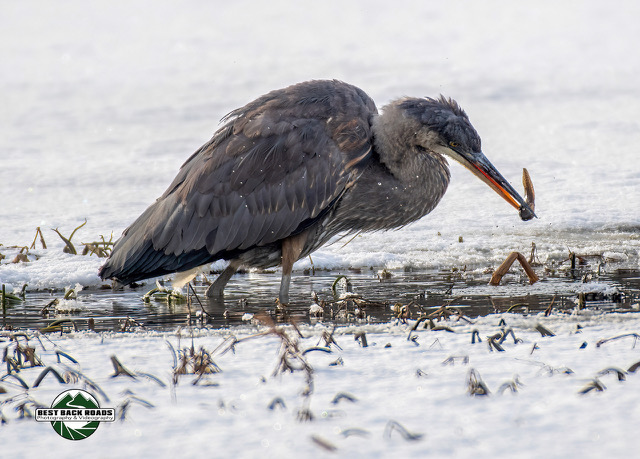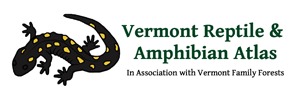
Groundwater, Ice, and Herp Survival – January 28, 2022
Groundwater helps keep herps alive in the winter
Herpers, I could not wait until next week to show you this great photo sent to me by wildlife photographer Rick Armitage. Rick lives in Whitehall, NY, but has sent quite a few valuable herp records with photos he has taken in nearby areas of Vermont.
Check out the juvenile Great Blue Heron feeding on a Green Frog tadpole in this photo Rick took earlier this week in West Haven. These small openings in the ice are often the result of ground water keeping the ice from freezing. The temperature of the water in the spring is probably around 42°F. Certainly cold by our standards, but above freezing and that is where many tadpoles, newts, and some frogs and turtles congregate in the winter.
In some springs on the margins of beaver ponds, we have seen hundreds of Eastern Newts congregating in huge masses. Not only is the water warmer, but it also contains more dissolved oxygen because it is moving and the oxygen content has not been depleted by decaying vegetation under the ice. You can also find open similar open springs in the winter on wooded hillsides, where the snow has been melted by the warmer ground water. These also are winter refugia for amphibians and sometimes Snapping Turtles.
This heron has found a life-saving buffet. Regarding the tadpole, Green Frogs this far north spend at least one and possibly two winters before getting large enough to metamorphose. My guess is this tadpole is in its second winter and would have become terrestrial next summer. By zooming in, I can tell it is a Green Frog tadpole by the irregular dark blotches on both the top and bottom fins. American Bullfrog tadpoles have distinct dots on only the top of their fins. No other tadpoles would be expected to overwinter.

Great Blue Heron preying on Green Frog tadpole at an icy pond. Photo © copyright Rick Armitage and used with permission.
Fundraiser
We are now only $676 from our goal of $25,000 for the upcoming year. Donations can still be made in a few ways:
Through our GoFundMe site: https://gofund.me/70b5be0e
By using the PayPal link on our website: https://www.paypal.com/paypalme/VtHerpAtlas
By sending a check made out to James S. Andrews to the address below (no overhead is lost).
By sending a check made out to Vermont Family Forests to the address below. This is our fiscal sponsor and they are a registered 501(c)3 non-profit (they take 15% for overhead costs).
Checks should be sent to:
The Vermont Reptile and Amphibian Atlas642 Smead Road
Salisbury, VT 05769

